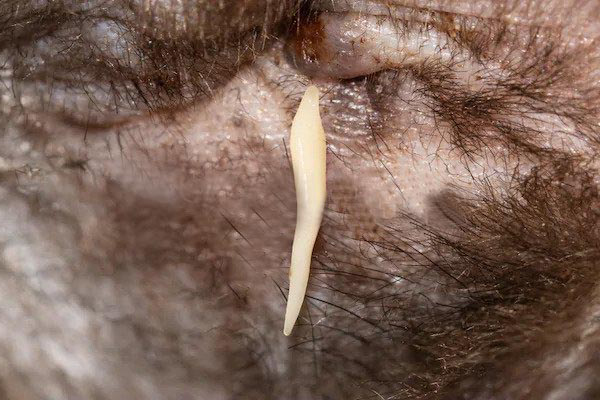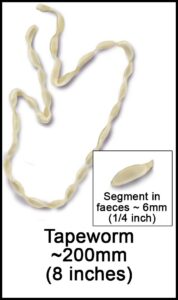
Tapeworms
 Tapeworms are long, flat worms that can vary in length. that commonly settle in cats’ bowels. They have a segmented body and a head, which has suckers and hooks to help them attach to the intestine. They reproduce by attaching themselves to the gut and breaking into a series of segments containing eggs, which are then passed out with the faeces.
Tapeworms are long, flat worms that can vary in length. that commonly settle in cats’ bowels. They have a segmented body and a head, which has suckers and hooks to help them attach to the intestine. They reproduce by attaching themselves to the gut and breaking into a series of segments containing eggs, which are then passed out with the faeces.
Your cat may pick a tapeworm up accidentally by eating tapeworm larvae. Many types of tapeworm larvae are found in fleas; if a flea is eaten, the tapeworm larvae begin to grow inside your cat. Some cats eat the poo of infected cats, which can pass on the tapeworm. It is also possible for mothers to pass on tapeworms to their young.
Symptoms
What to look for if you suspect your cat has a tapeworm.
- Check your cat’s poo. If they have what looks like small white/cream ‘grains of rice’ in them (Tapeworm segments), your cat probably has a tapeworm.
- You might see Tapeworm segments in the hair near to the anal region
- A cat that is often licking their anus.
- Biting or scratching at or around their anus.
- Dragging their hind legs across the floor in order to scratch the area.
- Tapeworms can also cause cats to lose weight, even though your cat’s appetite has increased.
- Your cat’s coat may become shabbier or duller than usual.
If you notice any of these signs it’s important to take your cat to see your vet as soon as possible. If noticed early, tapeworms are easy to treat and get rid of.
Treatments
Treating cat’s for tapeworms is a fairly easy process. First, take your cat to your vet for a diagnosis. Your vet will provide suitable medication which may be one of the following:
- Palatable tablets
- Spot-on wormers such as ‘Dronspot’
- Pastes or liquids that can be fed directly or mixed into food.
These types of treatment are simple and extremely effective, especially if you catch the parasite in its early stages.
Preventing tapeworms in cats
Kittens can have monthly preventative treatment against tapeworms from six weeks of age. After six months, they can have this treatment every three months. Adult cats can have this preventative treatment every two to six months, depending on their needs. Always consult a vet first to ensure preventative treatment is right for them.
Ingesting fleas is one of the main causes of tapeworms in cats. Flea spot treatments are a great way to discourage fleas from living on your cat. Ask your vet for advice about flea treatments.
